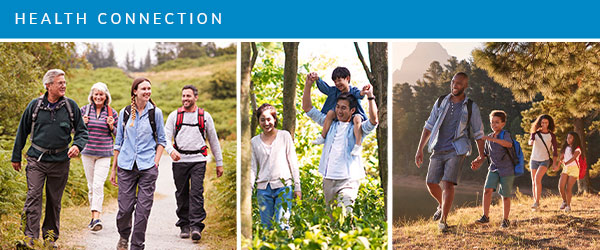Health Connection - Summer 2021

15 Months into the COVID-19 Pandemic: Adjusting to the latest "New Normal"
By Rebecca Maxwell, LCSW

Much has been written about the psychological effects of the pandemic—the loneliness, fear, depression, anxiety, and grief. People have experienced trouble sleeping. Some have turned to substance abuse. Others have developed marital issues. Many feel stressed and overwhelmed by all of the juggling, from working from home while helping kids with online learning to worrying about finances and relatives. Now that California has “reopened” and restrictions are looser, some will find their anxiety lifting. But for others, concerns and mental health issues may persist or even worsen.
Our Marin community has done spectacularly with vaccinations—as of this writing 92.8% of Marin residents ages 12 and over have had at least one dose—but the threat remains. There is still no closure as we face the Delta and other easily transmissible variants, and keep hearing about breakthrough infections and COVID “long-haulers.” Even if you’re fully vaccinated, it can be hard to parse where and when to mask up (in short: you don’t need a mask outside, but Marin and other Bay Area counties are recommending that everyone wear one inside in settings like grocery or retail stores).
Many of us are still feeling a sense of malaise, amplified by a year of protest and political turmoil, and some groups are especially vulnerable to mental health issues. Essential workers may be struggling with post-traumatic stress after months of emotionally draining work. The pandemic has exacerbated economic and healthcare discrepancies, hitting Black, Latino, and Indigenous people particularly hard. Families juggling work and childcare have experienced unprecedented pressures.
While some of us are thrilled to ramp up our social lives, people who are naturally introverted may feel differently. Those with compromised immune systems and parents of children who are too young to be vaccinated may also face awkward social situations or need to miss out on gatherings in order to prioritize their family’s safety. Some may struggle with a return to work—or with an employer’s decision to keep them working remotely.
Whatever challenges you are facing, there are measures you can take to reduce your anxiety.
- Work on your mindset. Anxiety is fear of the unknown, and the truth is, we’ve all had to adjust to a very serious unknown with COVID-19. If you’re concerned about returning to work, prepare in a positive way. Revisit your work wardrobe. Do a little shopping. Update your contact list. See if your favorite lunch places are still open. Give yourself permission to feel some trepidation. Remember, your worries are thoughts, not facts!
- Take a newsbreak. Consider unplugging from the media for a while. Pick a single news source, maybe your favorite newspaper or news show and cut out the rest of the noise.
- Take care of your body. Plan healthy, balanced meals. Avoid excess drinking. If you still smoke, focus on quitting. Get regular exercise and plenty of sleep.
- Actively relax. Making a big bowl of popcorn and watching a movie on the couch has its place, but there are more effective forms of emotional self-care. Explore more structured and mindful ways to relax such as yoga, meditation, tai chi, deep breathing, or visualization.
- Get back to nature. Hike, stroll, garden, or just sit on the beach and feel the sun and wind on your face. Tapping into the healing power of nature can boost your mood and concentration and help you arrive at a more positive perspective. Here’s a list of excellent natural Healing Places in Marin and Sonoma to get you started.
- Connect with others. Whether it’s with friends and family, people from your house of worship, or that new neighbor you haven’t met yet, it’s time to start socializing again.
- Volunteer. There are so many rewarding ways to “give back,” from volunteering at your child’s school or your local hospital, to exploring opportunities that match your hobbies and interests. Check out volunteermatch.org or volunteerinfo.org for ideas. Having a purposeful activity that helps others is a great way to get out of your head and refocus.
- Don’t hesitate to get help if you need it. Your friends may be good listeners, but there are times when it’s best to talk to someone understanding who does not know you personally. Talking to a therapist, religious leader, or support group can make all the difference. If you are in need of support, learn about behavioral healthcare treatment at MarinHealth Medical Center or call 1-415-925-8808 to speak with a clinical social worker who can point you in the right direction.
Rebecca Maxwell, LCSW is the Director of Behavioral Health at MarinHealth Medical Center
Be Cool, Stay Safe: Tips for a Safer Summer
Summertime, and the living is easy—and fun! We all deserve a break after months of social distancing, mask wearing, and sheltering in place. Now that things are gradually opening up, most of us can’t wait to enjoy the warm weather with family and friends. The tips below should help you do so as safely as possible.
Keep Your Eye on the Road—and the “Other Guy”
According to the National Highway Traffic Safety Administration (NHTSA), summer is peak accident season. Teen drivers are out of school and spending more time on the road. Hot weather increases the chance of car trouble and blow outs. Alcohol consumption is up. In addition, there tends to be more road work in the summer, making driving conditions less predictable. Plan ahead for road trips and make sure you get whatever servicing your car needs (new tires, oil change, etc.) checked off your to-do list before you leave.
Stay Safe on Two Wheels
Whether you’re riding a bike around the neighborhood or revving things up on a motorcycle, make sure you are aware of your surroundings—and that drivers are aware of you. Avoid busy roads and peak traffic times when possible. Wear bright colored clothes to make yourself more visible, especially at night, and put reflective tape on your bike. Wear a well-fitting helmet, and leave the headphones at home. Download more bike and motorcycle safety tips, or listen to this short podcast to learn more about preventing injuries and accidents on two wheels.
Be Cautious if Drinking
Other than the winter holidays, summer is peak drinking season. Alcohol impairs judgment and makes people more likely to take risks. When people drive, boat, bike, surf, or ride a jet ski under the influence, accidents happen. Swimmers may recklessly dive into water that’s too shallow, swim too far out, or develop hypothermia in cold water. Even if you’re just kicking back in the yard with your friends, excess alcohol consumption causes excess urination, increasing your risk for dehydration, heat exhaustion, and even heatstroke.
Watch Out in the Water
The most important water safety tip for families is to teach all the kids to swim. If you’re boating, make sure everyone wears a life jacket. Always keep an eye on young children. Whenever you are near water and suddenly lose track of a child, check the water first. Crowded conditions in a public pool can make it hard to see a child who has sunk to the bottom. If you have a home pool, make sure there are barriers around it and designate an adult “water watcher” when kids are playing in the pool.
Choose Destinations Carefully
We’re lucky to have some of Mother Nature’s finest gifts in Marin County or a short drive away, but some require extra precautions. Be mindful of currents or enjoy the Pacific from a safe distance. Remember there’s a reason Sonoma Coast beaches don’t have lifeguards: cold water, large surf, backwash, sudden drop offs, rip tides, and sneaker waves make swimming far too dangerous. Keep youngsters a safe distance from the water’s edge.
Be a Savvy Hiker
Always tell someone where you are going, especially if you’re hiking alone. Check the hike’s difficulty level in advance, especially if your hips and knees don’t like too many inclines. Wear sunglasses, sunscreen, and a hat that won’t blow away. Try to plan your hike so you can avoid the hottest time of day. Bring a lot of water and keep sipping: your body only absorbs about a half-liter of water per hour. Pack some electrolyte drink mixes to keep your sodium and potassium at healthy levels, and some trail mix for a complex carb energy boost. Know what poison oak looks like, and keep an eye out for snakes. Check yourself―and especially your dog―for ticks when you return.
Don’t Get Sick at the Picnic
Bacteria grow faster in warm weather. Keep raw foods chilled in a fridge or cooler until you’re ready to grill. Refrigerate cooked leftovers within an hour if it’s more than 90°F outside. Clean work surfaces, utensils, and the grill thoroughly before cooking. Throw away leftover marinade that’s been used on raw meat or seafood. Use a food thermometer to make sure meat is sufficiently cooked (145°F for beef, pork, and fish; 160°F for ground meats; 165°F for chicken or turkey).
Don’t be COVID Over Confident
Compared to many parts of the country, the North Bay has excellent vaccination rates for COVID-19. However, as the virus continues to mutate, it’s a good idea to maintain some precautions in crowded areas. Take advantage of the nice weather and enjoy outdoor (as opposed to indoor) restaurant dining. If you’re going on a road trip, make sure you have hand sanitizer on hand.
Protect Yourself from Sunburn
Wear a wide brimmed hat and sunglasses with 100% UV protection. At least 20 minutes before you go out in the sun, slather on a broad-spectrum sunscreen that’s at least an SPF 30, making sure to cover your face, ears, neck, tops of feet, and backs of hands. (Throw away last year’s sunscreens: they lose their potency after 1-2 years.) Reapply every 2 hours and each time you get out of the water. Children tend to jump in and out of the water quite a bit and require more frequent sunscreen applications! Sunscreen is not recommended for infants younger than 6 months and it’s best to just keep them out of the sun entirely. Get more sun safety tips.
Know the Difference Between Dehydration, Heat Exhaustion, and Heat Stroke
Dehydration, heat exhaustion, and heat stroke are a continuum. If dehydration is not addressed, it will lead to heat stroke, followed by heat exhaustion. Prevention requires a touch of common sense. If the forecast predicts extreme heat, don’t over exert yourself or stay outdoors for long periods of time. Plan outdoor activities for before 11 am or after 5 pm. Always have water with you and take frequent sips. If you or a loved one have symptoms of dehydration or heat exhaustion, seek shade or shelter immediately, drink plenty of cool water or sports drinks, and rest. If heat exhaustion symptoms don’t improve within an hour, contact your doctor. If you sees signs of heat stroke, call 9-1-1 immediately. Delaying treatment can result in brain, heart, or kidney damage.
| SYMPTOM | DEHYDRATION | HEAT EXHAUSTION | HEAT STROKE |
| Headache | • | • | • |
| Dizziness | • | • | • |
| Increased sweating | • | ||
| Very heavy sweating | • | ||
| No sweating | • | ||
| Extreme fatigue | • | • | • |
| Lack of urination, dark colored urine | • | • | • |
| Pale, clammy skin | • | ||
| Hot, sweaty, red skin | • | ||
| Hot, dry red skin | • | ||
| Rapid pulse/increased heart rate | • | • | |
| Decreased blood pressure | • | • | |
| Normal or slightly elevated temperature | • | • | |
| Very high temperature (over 104°) | • | ||
| Nausea | • | • | • |
| Fainting | |||
| Rapid, shallow breathing | • | ||
| Disorientation, irritability, hallucinations | • | ||
| Seizures | • | ||
| Loss of consciousness or coma | • |
Bladder Control Problems: Common and Treatable

Nearly half of American women experience some degree of urinary leakage (urinary incontinence). Urinary leakage is common among young women but the rates go up with age.
Some women are embarrassed to even bring up the topic, while others think that the problem is too minor to mention. Still more women worry they may need surgery or believe that the problem is just a normal part of aging. As a result, this common, treatable problem too often goes untreated.
There are two main types of incontinence that affect women:
Stress incontinence is loss of urine that occurs when a woman’s abdominal pressure increases, such as when coughing, sneezing, and exercising.
Some women leak occasionally. For example, when they have a cold, exercise strenuously, or have a very full bladder. Some women have a significant amount of leakage with minimal exertion, such as when walking down-hill, getting up from a chair, or bending over.
Overactive bladder (OAB) is a condition where the bladder muscle is overactive and squeezes too often. Women feel a strong, sudden urge to urinate, which is sometimes followed by leaking. It is common to feel frequent urges to go even though the bladder is not full.
Women with OAB may leak on the way to the bathroom, or while they are pulling down their clothes. Some women experience complete emptying of their bladder with little warning. OAB affects approximately 15% of woman and occurs more frequently as a woman ages. Unless OAB is caused by a temporary situation, such as a urinary tract infection (UTI), or as a side effect of certain medications, the condition will not resolve on its own.
Some women may suffer from “mixed incontinence,” a combination of both stress incontinence and OAB.
Regardless of severity, these symptoms can lead women to limit their physical and social activities, resulting in a significant impact on their quality of life.
Evaluating Urinary Incontinence
The first step to speak with your OB/GYN or primary care provider about your symptoms. Initially, your doctor will prescribe conservative treatment for both stress incontinence and OAB. Lifestyle modifications that can help include losing weight, pelvic floor rehab exercises, and fluid intake modifications. If conservative measures don’t yield results, your doctor may refer you to a specialist in female pelvic medicine and reconstructive surgery (FPMRS).
Specialist evaluation will include a thorough history and pelvic exam. Common tests include a urinalysis to make sure you don’t have a UTI, and a post-void residual measurement, which measures how much urine remains in your bladder after you relieve yourself. You may be asked to keep a bladder diary for several days to better understand your urinary habits. In certain cases, urodynamic testing may be required to understand what parts of your bladder and urethra are functioning correctly, and which parts are not.
Treating Urinary Incontinence
Stress incontinence is treated by supporting the bladder and urethra. Pelvic floor exercises can help strengthen the pelvic floor. In many cases, exercises alone are unable to control leakage. In these instances, further interventions are required to control stress incontinence. A vaginal insert, such as a pessary, is a low-risk option to treat stress leakage. There are also several surgical approaches, such as a midurethral sling, to support the bladder and urethra.
Overactive bladder treatment is focused on calming the nerves of the bladder muscle. Women are advised to eliminate bladder irritants such as soda, coffee, and carbonated beverages. Topical estrogen cream help improve the health of urogenital tissues. Bladder re-training techniques can be employed to gradually increase the time between bathroom visits. Oral medications can help the bladder hold more urine for a longer period of time.
Advanced treatments can be used for women with overactive bladder who do not respond to medications and initial therapies. Botulinum toxin (Botox) can be administered to relax the bladder muscle. Tibial nerve stimulation (PTNS) and sacral neuromodulation (SNS) are a forms of neuromodulation that deliver small electrical impulses to nerves that control the bladder in order to restore normal bladder control.
If urinary incontinence is interfering with your routine and affecting your quality of life, it’s time to seek treatment. With the many treatment options now available, there’s no reason to suffer in silence. Talk to your doctor instead.
Help is available right here in Marin. Learn more about female incontinence, find a MarinHealth® doctor near you, or call 1-415-527-0677.
Sujatha Pathi is a board certified urogynecologist practicing at MarinHealth Urogynecology | A UCSF Health Clinic.
Pediatric Cold Symptoms

Amid last year’s constant COVID-19 coverage was what seemed like a nugget of good news: 2020 was the mildest flu season on record. With most Americans following public health advice to mask up and many public settings shutting down, the transmission of all airborne viruses was temporarily suppressed, and lots of kids went an entire year without so much as a sniffle. The bad news? Our return to normal over the past few months, including reduced mask wearing and social distancing, means the common cold and other viruses are coming back. As a result, pediatricians all over the country are seeing more babies and young children with colds, pneumonia, and other respiratory viruses.
Adults are also contracting these illnesses, but their symptoms tend to be milder and don’t usually require a visit to the doctor. Young children are more at risk for several reasons:
- Pandemic protection measures have disrupted the normal season for respiratory viruses such as the flu and respiratory syncytial virus (RSV). The most common cause of bronchial infections and pneumonia in babies, RSV has a season that normally runs from November to early spring. This year, pediatricians began seeing a surge in RSV infections in March, and it has continued into the summer months.
- Months of isolation kept adults from catching a variety of airborne viruses. Now that the country is opening back up, adults are contracting these viruses and bringing them home to their families.
- While years of built-up immunity keep adults from getting very sick, very young children are more vulnerable.
- More children are also returning to daycare and camps and being exposed to whatever bugs are going around.
By the time they reach the age of two, nearly all children will have had at least one RSV infection, with only mild cold symptoms to show for it. However, 58,000 children are hospitalized with RSV every year. Those at greatest risk for severe illness from RSV include:
- Infants 6 months and younger
- Children under the age of 1 who were born premature
- Children younger than 2 years old with chronic lung disease or congenital heart disease
- Children with weakened immune systems
- Children with asthma or other breathing difficulties
- Children who have neuromuscular disorders and who have difficulty swallowing or clearing mucus secretions
If your child is younger than 2 and has any of the risk factors listed above, talk to your doctor about the risk of RSV.
When to Worry: Signs of Serious Illness in Babies and Toddlers
If your child’s symptoms and behavior are in the “No Worries” column, you can relax—at least for now. Keep in mind that symptoms may worsen quickly, so keep a close eye out for sudden changes. If your child’s signs are “Worrisome,” you should call your pediatrician’s office for advice. When symptoms are in the “Serious,” category, make an appointment to see the doctor right away or go to an urgent care center.
If your child is unconscious, has difficulty breathing, or looks pale or blueish in color, CALL 911.
| NO WORRIES | WORRISOME | SERIOUS | |
| Appearance | Child is bright eyed and alert. | Sleepy, dull-eyed, listless. | Glassy-eyed, staring blankly. |
| Crying | Child is crying normally for the usual reasons. | Crying is whiny and hard to comfort. | Weak cry. Moaning. Child continues to cry when comforted. |
| Activity level | Child plays and sleeps normally. | Child sleeps more than usual and fusses when awake. | Child has no interest in playing and is hard to awaken. |
| Appetite | Appetite is normal. Child may let you know he or she is hungry. | Child will take a few bites or sips when offered food, milk, water, or juice, but not that interested in eating. | Child pushes food away or refuses all food and liquids. |
| Urination | Child urinates as often as usual, and urine is light yellow. | Child urinates less than normally, and urine is dark yellow. | Child makes very little urine, has little saliva, and produces few tears when crying. |
Of course, prevention is the best medicine. Keep up the diligent hand washing your kiddos have gotten used to during the pandemic, and if you or your children do get sick, stay home to avoid passing on those germs. Make sure your child stays on schedule for routine well visits, and follow your pediatrician’s advice for regular vaccinations—including the flu shot as we’re likely to see a return of flu this fall. Find a MarinHealth pediatrician.
Cindy J. Greenberg is a board certified pediatrician practicing at MarinHealth Pediatric Care | A UCSF Health Clinic in San Rafael.

